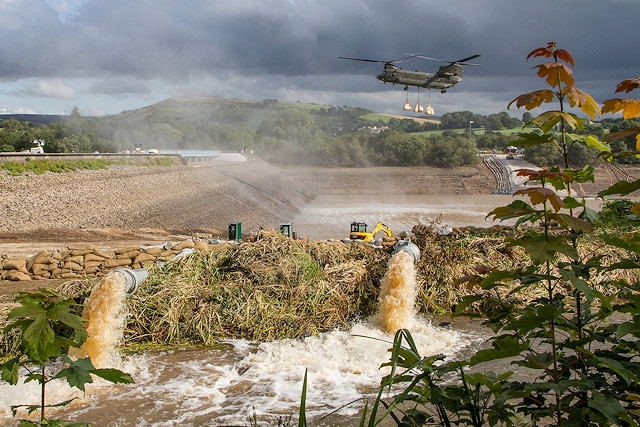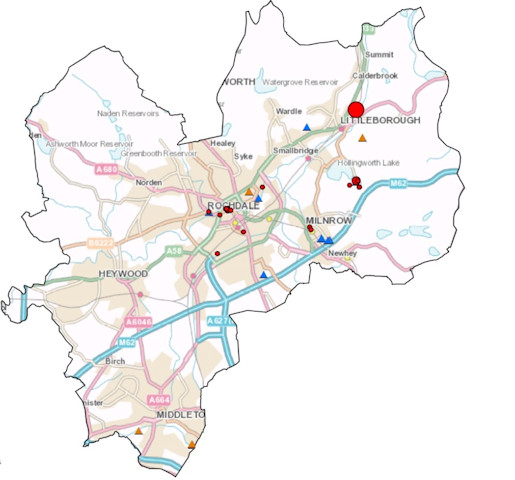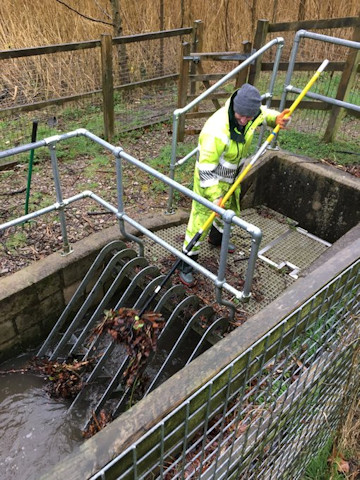A cleaner and greener borough with the Environment Agency
Date published: 22 September 2019

RAF chinook and water
Hello from everyone at the Environment Agency and welcome to our latest round-up exclusively for Rochdale Online. By now, you will all have heard the stories of how 1,500 people were evacuated from a small town called Whaley Bridge back in August. A town known for its impressive reservoir, Toddbrook, and now, forever remembered for the day it threatened to collapse.
However, it wasn’t just Whaley Bridge that fell victim to extreme weather and this month, we are using our round-up to take a look back at the flooding that hit many parts of the North West over the summer and how we are now moving forward with recovery.
Recovery work goes on after heavy flooding
There is no doubt that the North West, and indeed the whole of the UK, boasts a unique and stunning landscape which is often defined by its changing seasons and unpredictable weather patterns, which can sometimes hit with little or no warning.
Desmond. Eva. Callum. Whaley Bridge. We tend to remember the big-name storms and flooding events that take over the news reports for weeks and months, offering up poignant images of waterlogged town centres and rescued families.
Yet many of us barely notice the losses racked up annually from flooding events all over the North West such as flash floods in the River Roch catchment, torrential rains in bone-dry watercourses last summer and flood alerts put out across the region in July and August 2019 as a result of severe and persistent rainfall.
Flooding, and managing it, costs the UK around £2.2 billion each year. The most well-known risk reducer is, of course, flood alleviation schemes and Greater Manchester, Merseyside and Cheshire benefit from several extensive and complex flood defences with several more planned for the region by 2021. These defences provide us with an ‘adaptable strategy’ to manage future risk depending on how conditions, such as river levels, change over time.
However, it is fair to say that the summer of 2019 has surpassed itself for extreme weather conditions. From the 29th July, unusually intense rainfall caused river levels in Greater Manchester to rise rapidly with some affected communities seeing more than a month’s worth of rainfall in less than five days.
The Environment Agency’s defences protected thousands of homes and businesses from flooding and we were also able to provide flood warnings and alerts to over 15,000 properties prior to the event. Unfortunately, a number of properties were still directly affected including several within the Rochdale and Littlebrough area (as seen on the map below).

Our experience of responding to severe weather events across Greater Manchester in recent years meant that we were ready to react. Both our Warrington-based Incident Room and our Operational Teams out on the ground provided a non-stop service, both day and night, to our partners, emergency services and affected communities.
During this time, they responded to almost 400 individual reported incidents for the flooding event alone.
In Rochdale, the teams operated pumps alongside our emergency services, and kept the rivers free of blockages (one of the most common causes of flooding) by clearing tens of tonnes of debris from numerous screens and grids across the community.

The focus is now very much on recovery and in the aftermath of the flooding, our Community Information Officers have visited towns across Greater Manchester offering information to residents as well as signposting people to help and advice. Our Operational Teams are back out on the ground implementing a well-tested programme of prevention, planning, response and recovery work as well as carrying out detailed assessments of our assets and rivers to ensure our communities are as flood resilient as they can possibly be.

We are also working closely with a number of our partners including Local Authorities to ensure impacts to the biodiversity within our rivers is minimised if not prevented, and that the water quality of those areas affected by flooding is maintained. There is now monitoring in place to ensure those short and long term impacts can be measured and acted upon.
Taking the next step in flood risk management for Rochdale
After another wet period in late July and August it’s a good time for the project team to update you around work on the proposed flood scheme in Rochdale and Littleborough. Over the past month we have had staff out across the borough working closely with Rochdale Borough Council to speak to residents and businesses who may have been affected by the recent bad weather.
You may remember the construction of the scheme is planned to be in two phases – Phase 1 (Littleborough) and Phase 2 (Rochdale – downstream of Smithy Bridge). We are phasing the construction works in this way because by beginning upstream, the benefits will include a reduced flood risk for residents and businesses in Littleborough, Smallbridge and Rochdale at the earliest opportunity.
Back at our main office in Warrington, the project team continues to develop the detailed design for Phase 1, and we now hope to submit our planning application before Christmas and consult with the Littleborough public around the same time to ensure that both residents and businesses have chance to comment and understand proposals.
Detailed design for Phase 2 will again begin before Christmas and we look forward to engaging with the residents, partners and businesses in the area at the same time. We are committed to delivering the scheme as quickly as we can and will work closely with Rochdale Borough Council and our other partners to ensure we are in a position to start work on site as quickly as possible.
Once completed, the future flood scheme will increase the level of protection to 1,000 residential properties as well as critical infrastructure such as the tram network, bus station, a grid sub-station as well as a wastewater treatment works. Throughout autumn, we hope to hold hope to hold a number of drop-in sessions to give residents and businesses an update on the progress. Watch this space for more information about those.
As always, it is worth noting, that even with flood defences in place, you can never entirely remove the risk of flooding. The recent wet weather has reminded us all of the importance of being prepared and you can check your risk as well as signing up for free flood warnings by phoning Floodline, on 0345 988 1188, or by going online:
Don’t forget to say hello
It’s that time of year when our Operational Teams get underway with our big annual maintenance programme of our assets including embankments, channels, culverts and debris screens to make sure they’re ‘winter ready.’ If you do spot us out and about in the Rochdale community don’t forget to say hello or give us a wave.

Stay in touch
You can stay up-to-date with the latest news and information from the Environment Agency on Twitter and Instagram at @EnvAgencyNW.
We look forward to sharing more of our stories and successes with you in November.
Do you have a story for us?
Let us know by emailing news@rochdaleonline.co.uk
All contact will be treated in confidence.
Most Viewed News Stories
- 1Royton haulage firm fined after Rochdale dad went to work and didn’t come home
- 2Six men arrested in Rochdale child exploitation investigation
- 3Newhey's Char Steakhouse and Bank Chamber close with immediate effect
- 4Two men arrested after police chase ends up in Middleton river
- 5Obituary: Jean Ashworth
To contact the Rochdale Online news desk, email news@rochdaleonline.co.uk or visit our news submission page.
To get the latest news on your desktop or mobile, follow Rochdale Online on Twitter and Facebook.


